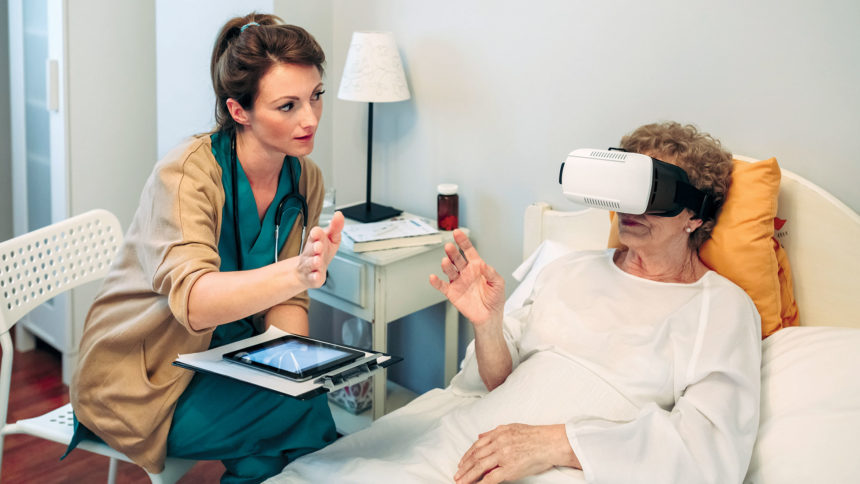
Technology is fast becoming as important an allure as the bricks and mortar and all the amenities they surround in assisted and other non-skilled long-term care.
“From my perspective, assisted living communities have by far adopted the most technology,” says Laura Wasson, owner and executive director of sales for Tech Electronics. “Using the latest technology in their communities appeals to residents and their families and allows them to better market themselves to private-pay insurers. Part of what drives this is the rapidly increasing competition in the assisted living industry.”
Adds Travis Palmquist, vice president and general manager for PointClickCare: “Without question, the senior living market is investing in technology at a much brisker pace. We are seeing many organizations actively pivot from hospitality models to more holistic hospitality, health and wellness models.”
Part of the reason is senior living tech has become affordable and user-friendly.
“The demand for cutting-edge technology is really across the board,” says Mike Webster, CPP, director of senior living, fall management and security solutions for Stanley Healthcare. “‘Cutting-edge’ doesn’t have to mean complex. In fact, one of the advantages of newer technology is that it is often less complex, taking advantage of standards-based technologies that do away with a lot of hard wiring and proprietary devices.”
“The more your facility surrenders its core security functions to an AI, which is vernacular for robot, or artificial intelligence, the more likely it is that lines of personal autonomy will not be respected,” says Patrick Hardy, LL.M., CEM, MEP, CRM, president and CEO of Hytropy, a continuity and disaster planning solutions provider. And in their search for greater resident safety, “well-meaning family members sometimes create policy quagmires. One of the major issues involves so-called ‘granny-cams,’ whose live feeds can create a host of legal issues regarding privacy of residents, staff and guests. Facility policies need to address this issue.”
Other reserved stakeholders are clinicians.
“We have seen clinical teams more resistant to newer technologies primarily because of the liability,” says Fahad Aziz, cofounder and chief technology officer of Caremerge. “They choose to work with platforms that, in most cases, were developed two decades ago, but which they think work for them. The way they see it, change only brings uncertainty.”
Scratching the surface
Still, many believe senior living operators have only scratched the surface of all that technology has to offer today.
“We are just on the cusp of a larger technology demand that is going to arrive with baby boomers,” says Jeremy Spradlin, CEO of CareServ Technologies and Consulting. “Baby boomers are not only going to put additional pressures on senior living communities to use technology to provide better care; they are also going to demand access to technology for their own personal use and comfort. The next generation to arrive in senior living communities is tech-savvy and thus, they are going to expect their community and care-givers to embrace technology.”
It’s understandable if they’re sometimes reticent.
In other cases, communities may find themselves more enamored by testing than adopting new tech.
Getting pilots off the ground is one thing. For many, problems arise when it comes to taking them to the next logical step, which for many means implementing on a broad scale.
Few understand this better than Majd Alwan, Ph.D., senior vice president, technology, for LeadingAge and executive director of LeadingAge Center for Aging Services Technologies.
“I believe it’s important for aging services providers to be involved in technology design and development and to serve as a real-life testing and evaluations to advance the field of aging services and aging services technologies,” Alwan says. “However, they need to be judicious about what they engage with.”
At times, tech adoption in senior living can be stymied by procedural failures. This happens often in tech pilots with vendors.
Jody Holtzman, who spent more than two decades at AARP, most recently as the organization’s senior vice president of thought leadership and market innovation, had seen his share of technology pilots in senior living before transitioning to his current role as senior managing partner for Longevity Venture Advisors LLC.
“Everyone is doing tons of pilots. Every conference we went to was ‘pilot-titis’,” he quipped. “But no one knows what to do when the pilots are over. And I think this is true for long-term care facilities as well. They’re getting confronted with what is no shortage of tools of various kinds. What I don’t hear from them is the synthesis, the takeaways. What did and didn’t work? What will they never do again? If they could identify it, what was the one thing that really contributed to better outcomes, like keeping people out of the hospital or saving money?”

